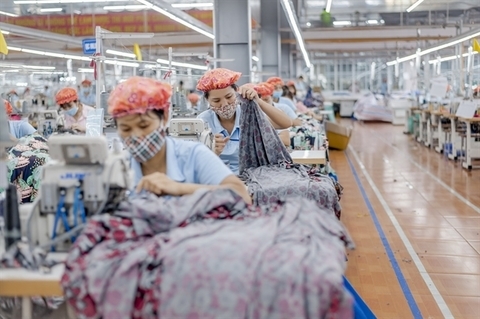During three periods of social distancing because of the Covid-19 pandemic since early 2020, there were times when Tran Thu Huong, a 32-year-old woman in Hanoi, felt very stressful because she had to stay at home to look after her two children who could not attend school.
 |
|
|
Huong, an accountant, is quite busy, especially on the last days of the month. Hanoi closed schools for three times and during these times Huong asked her boss’ permission to work from home.
Huong has two children aged 3 and 5. Her parents and parents-in-law are old, and they live far from Hanoi, so Huong could not ask for their help to take care of her kids. She was unable to hire a babysitter so she had to work from home when her kids could not attend school.
Because of this, for more than a year, the atmosphere in her family has always been tense. During the day, she had to both work and take care of the children so in the evening, when her husband came home, she was exhausted.
Sometimes she was too tired and complained to her husband. But when her husband suggested hiring a maid, she refused.
She said she is still luckier than many others who cannot work from home. “My neighbor has to leave her two children, 4 and 7 years old, at home to go to work because the nature of her work cannot be done remotely. Some people have to quit their jobs to stay at home to look after their children because their salary is low,” Huong said.
The story of the "double responsibility" of Huong and many other women during the pandemic is also reflected in a study conducted in March this year of the International Labor Organization (ILO) in Vietnam.
The study entitled “Gender and the Labor Market in Vietnam” affirmed that the Covid-19 pandemic not only deepened existing inequalities but also created new gender inequalities.
Vietnamese women are facing many persistent inequalities in the labor market - carrying on their shoulders the double burden of working and taking care of the family. This burden is even more pronounced after the pandemic broke out.
Since the Covid-19 pandemic began, the labor force participation rate has dropped sharply for both women and men, but women have experienced a sharper decline. The labor force participation rate of women in 2020 compared to that in the fourth quarter of 2019 decreased by 4.8 percentage points to 66.2%, while that of men decreased by 3.9 percentage points, to 77.4%.
In 2019, there was almost no disparity between men and women in the country in terms of unemployment rate. By the end of the third quarter of 2020, the disparity appeared to be unfavorable for women, especially young women.
Total weekly working hours of women during the second quarter of 2020 was equivalent to 88.8% of their total working hours in the fourth quarter of 2019. The figure for men was 91.2%.
Women's "double responsibility" is also reflected in the number of hours of housework compared to men. Specifically, women spend an average of 20.2 hours a week on cleaning the house, washing clothes, cooking and shopping, and taking care of the family and children while men spend only 10.7 hours on these tasks. Nearly 20% of men don’t spend any time at all on housework.
The quality of employment of women is lower than that of men
In fact, more than 70% of Vietnamese women of working age participate in the labor force - much higher than the average rate in the world as well as in the Asia-Pacific region. However, the research indicates that the active participation of Vietnamese women in the labor force should not be misunderstood as an indicator that Vietnamese women enjoy equal opportunities.
“Before the Covid-19 pandemic broke, both women and men had easy access to jobs, but in general, the quality of jobs for women was lower than that of men,” Valentina Barcucci, ILO Vietnam's expert, the study's lead author, said.
Female workers account for the majority of vulnerable jobs, especially housework. Their earnings are lower than men's - monthly wages in 2020 were 13.7% lower than in 2019 - even though their working hours are comparable to men's, and the gender gap in educational attainment has narrowed significantly. Those are the reasons why the unemployment rate among women, the rate of women leaving the job market was higher when the pandemic occurred.
“The inequality for women in terms of job quality and career development also stems from the dual responsibility they have to shoulder,” ILO expert Barcucci said.
Changing thinking and behavior
Legally, the new Labor Code that took effect on January 1, 2021 stipulates that female workers will no longer be excluded by law from a number of occupations that are considered harmful to the function of caring and raising children. Instead, they will have the choice of whether or not to do those jobs after being fully advised of the risks involved. These signs of progress indicate a willingness to improve equal opportunity in the world of employment.
Dr. Chang-Hee Lee, Director of ILO Viet Nam, said the root of inequality in the labor market are the traditional roles that women are expected to play, and these expectations are reinforced by social standards.
“Although at the policy level, the Labor Code 2019 has opened up opportunities to close the gender gap, such as closing the gap in the retirement age or removing restrictions on women's participation in a certain kind of occupations, Vietnam still has an even more difficult task to complete. It is changing the mindset of Vietnamese men and women themselves, thereby changing their behavior in the labor market.”
Nguyen Thao

Emotional abuse against women is viewed as acceptable by many in society
Many people still think that it is normal when couples scold each other harshly at home.

Many women suffer from 'emotional abuse' at home
Like many other nights, Quang cursed his wife and children when Hue, his wife, asked for money to buy food.